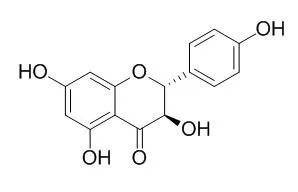| Description: |
Aromadendrin possesses anti-inflammatory, antioxidant, and anti-diabetic properties, it exhibits anti-inflammatory activity through the suppression of nuclear translocation of NF-κB and phosphorylation of JNK in LPS-stimulated RAW 264.7 macrophage cells. Aromadendrin treatment induces adipogenesis by increases in PPARγ2 expression, resulting in stimulation of glucose uptake and ameliorated insulin resistance, suggests that it may represent a potential therapeutic candidate for the management of type 2 DM. Aromadendrin has inhibitory activity on aldose reductase and the formation of advanced glycation end products. |
| In vitro: |
| Pharmacology. 2011;88(5-6):266-74. | | Stimulation of glucose uptake and improvement of insulin resistance by aromadendrin.[Pubmed: 22056597] | Agents that stimulate glucose uptake and improve insulin resistance may be useful in the management of type 2 diabetes mellitus (DM). Thus, the aims of this study were to assess the effects of Aromadendrin, a flavonoid from Gleditsia sinensis Lam., on stimulation of glucose uptake and improvement of insulin resistance and to characterize the molecular mechanisms underlying these activities.
METHODS AND RESULTS:
Insulin-stimulated glucose uptake was measured in HepG2 cells and in differentiated 3T3-L1 adipocytes using 2-[N-(7-nitrobenz-2-oxa-1,3-diazol-4-yl)amino]-2-deoxy-D-glucose (2-NBDG), a fluorescent D-glucose analog. Expression of the peroxisome proliferator-activated receptor-γ2 (PPARγ2) and adipocyte-specific fatty acid binding protein (aP2) mRNAs and the PPARγ2 protein was analyzed in adipocytes using RT-PCR and immunoblotting, respectively. Insulin-stimulated protein kinase B (Akt/PKB) phosphorylation was measured in high glucose-induced, insulin-resistant HepG2 cells. Similar to 30 μmol/l rosiglitazone, treatment with 30 μmol/l Aromadendrin significantly stimulated insulin-sensitive glucose uptake in both HepG2 cells and 3T3-L1 adipocytes. Aromadendrin treatment also enhanced adipogenesis and caused increases in the expression of PPARγ2 and aP2 mRNAs and the PPARγ2 protein in differentiated 3T3-L1 adipocytes. In high glucose-induced, insulin-resistant HepG2 cells, Aromadendrin reversed the inhibition of Akt/PKB phosphorylation in response to insulin, which could be abrogated by pretreatment with LY294002, a phosphatidylinositol 3-kinase (PI3K) inhibitor. Aromadendrin treatment induced adipogenesis by increases in PPARγ2 expression, resulting in stimulation of glucose uptake and ameliorated insulin resistance.
CONCLUSIONS:
These findings suggest that Aromadendrin may represent a potential therapeutic candidate for the management of type 2 DM. | | Food Sci. Biotechnol., 2011, 20(5):1283-8. | | Inhibitory Activity of Aromadendrin from Prickly Pear (Opuntia ficus-indica) Root on Aldose Reductase and the Formation of Advanced Glycation End Products.[Reference: WebLink] |
Prickly pear (Opuntia ficus-indica) is a longdomesticated crop plant of arid and semiarid parts of the world.
METHODS AND RESULTS:
The efficacy of extracts of prickly pear root for managing diabetes and diabetes complications was evaluated using a variety of in vitro bioassays. The ethyl acetate-soluble fraction was most effective in the prevention of diabetes and its complications via the inhibition of rat lens aldose reductase activity, the formation of advanced glycation end products, and α-glucosidase activity.
CONCLUSIONS:
MS and NMR were used to identify the bioactive compound from the ethyl acetate-soluble fraction as 3,5,7,4′-tetrahydroxyflavanone (Aromadendrin). |
|






 Cell. 2018 Jan 11;172(1-2):249-261.e12. doi: 10.1016/j.cell.2017.12.019.IF=36.216(2019)
Cell. 2018 Jan 11;172(1-2):249-261.e12. doi: 10.1016/j.cell.2017.12.019.IF=36.216(2019) Cell Metab. 2020 Mar 3;31(3):534-548.e5. doi: 10.1016/j.cmet.2020.01.002.IF=22.415(2019)
Cell Metab. 2020 Mar 3;31(3):534-548.e5. doi: 10.1016/j.cmet.2020.01.002.IF=22.415(2019) Mol Cell. 2017 Nov 16;68(4):673-685.e6. doi: 10.1016/j.molcel.2017.10.022.IF=14.548(2019)
Mol Cell. 2017 Nov 16;68(4):673-685.e6. doi: 10.1016/j.molcel.2017.10.022.IF=14.548(2019)